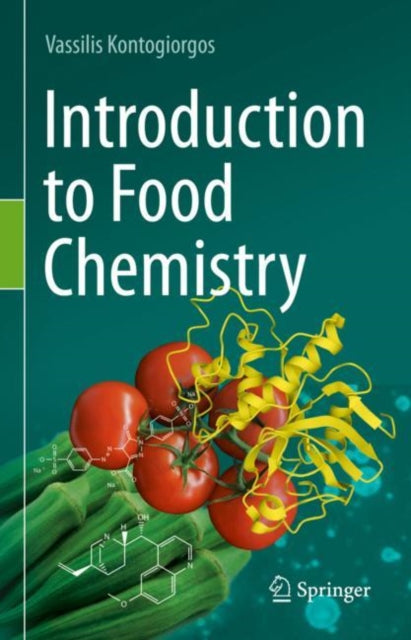Vassilis Kontogiorgos
Introduction to Food Chemistry
Introduction to Food Chemistry
YOU SAVE £41.79
- Condition: Brand new
- UK Delivery times: Usually arrives within 2 - 3 working days
- UK Shipping: Fee starts at £2.39. Subject to product weight & dimension
Bulk ordering. Want 15 or more copies? Get a personalised quote and bigger discounts. Learn more about bulk orders.
Couldn't load pickup availability
- More about Introduction to Food Chemistry
Food chemistry is a challenging subject for students studying in a food science course. Introduction to Food Chemistry bridges this gap in the relevant literature by employing the latest pedagogical theories in textbook writing to present the subject to students with broad range of cognitive skills. It has specific learning objectives for each chapter and is self-contained, with built-in pedagogy and learning activities at the end of each chapter. It also has a conversational writing style without losing academic rigor and helps focus teaching preparation on key aspects of food chemistry relevant to both industry and modern research. For lecturers in search of a singular source to aid in their introductory food chemistry courses, Introduction to Food Chemistry is the ideal choice.
Format: Hardback
Length: 205 pages
Publication date: 02 December 2021
Publisher: Springer Nature Switzerland AG
The intricacy of food chemistry poses significant challenges for students enrolled in food science courses. While there are numerous excellent food chemistry books available in the market, they often fall short in two critical aspects: their encyclopedic nature, which makes it difficult for students to discern what is essential, and their inadequate suitability for undergraduate food science students. The first problem hinders students' ability to prioritize and allocate their learning resources effectively. The second issue arises when books are authored by individuals who lack food science expertise, such as chemists who are not actively involved in teaching or who may not possess the necessary qualifications to effectively impart knowledge. Consequently, there is a disconnect between the chemistry of foods and its practical applications or potential implications for students' future employment prospects.
To address this gap in the relevant literature, Introduction to Food Chemistry emerges as a valuable resource. This textbook employs the latest pedagogical theories in textbook writing to effectively convey the subject matter to students with diverse cognitive abilities. The book is designed with specific learning objectives for each chapter, ensuring that students have a clear understanding of the key concepts covered. Furthermore, it is self-contained, meaning that students can obtain all the necessary information within the textbook without the need for additional outside sources.
To enhance learning, Introduction to Food Chemistry incorporates a range of didactic elements. Information is conveyed through 3D figures, color-coded schemes, and graphs, which help to visualize complex concepts and make them more accessible. Annotations on the figures provide links to the text descriptions, facilitating a deeper understanding of the material. Additionally, built-in pedagogy and learning activities are included at the end of each chapter, aligning with the learning objectives. These activities encourage students to engage with the content and apply their knowledge in practical scenarios.
Furthermore, the book incorporates keywords and concepts for online search, fostering curiosity and encouraging further studies. The conversational writing style employed ensures that academic rigor is maintained without compromising readability, making the text accessible to a wide range of students.
To support lecturers, Introduction to Food Chemistry offers valuable resources. It helps lecturers focus their teaching preparation on the key aspects of food chemistry that are relevant to both in-class instruction and independent study. The book provides comprehensive coverage of the subject matter, making it an essential resource for both undergraduate and graduate food science courses.
In conclusion, the complexity of food chemistry makes it a challenging subject for students studying in a food science course. Introduction to Food Chemistry bridges this gap in the relevant literature by employing the latest pedagogical theories, presenting the subject matter in a self-contained manner, and incorporating didactic elements to enhance learning. The book's built-in pedagogy and learning activities, coupled with keywords and concepts for online search, foster curiosity and encourage further studies. Additionally, it offers valuable resources to support lecturers in their teaching preparation, making it an essential resource for both undergraduate and graduate food science courses.
Weight: 494g
Dimension: 235 x 155 (mm)
ISBN-13: 9783030856410
Edition number: 1st ed. 2021
This item can be found in:
UK and International shipping information
UK and International shipping information
UK Delivery and returns information:
- Delivery within 2 - 3 days when ordering in the UK.
- Shipping fee for UK customers from £2.39. Fully tracked shipping service available.
- Returns policy: Return within 30 days of receipt for full refund.
International deliveries:
Shulph Ink now ships to Australia, Belgium, Canada, France, Germany, Ireland, Italy, India, Luxembourg Saudi Arabia, Singapore, Spain, Netherlands, New Zealand, United Arab Emirates, United States of America.
- Delivery times: within 5 - 10 days for international orders.
- Shipping fee: charges vary for overseas orders. Only tracked services are available for most international orders. Some countries have untracked shipping options.
- Customs charges: If ordering to addresses outside the United Kingdom, you may or may not incur additional customs and duties fees during local delivery.


